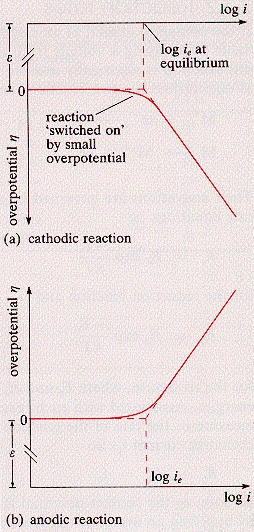| Corrosion & Environmental Degradation |
|
||||||||||||
|
|
|
|||||||||||
| ·The
net current flowing when an overpotential is applied is found from the
difference between the reduction and oxidation reaction rates:
RR - RO = i(η) = ie{ exp+(neη)/kT - exp-(neη)/kT} · For only small overpotentials, the second term becomes very small and the equation may be approximated as: i(η) = ie{ exp+(neη)/kT} i.e.: Ln i(η) = Ln( ie) + (neη)/kT or Ln {i(η)/( ie)} = η(ne)/kT ·The curves show this overpotential effect for reduction and oxidation reactions. · At the electrode potential, ε, the current of each reaction is just the equilibrium exchange current, ie. · When an overpotential, η, is applied, the logarithm of the net current increases linearly with the overpotential. This "Tafel plot" may be used to determine the exchange current density by using the extrapolations shown on the diagram. From: Newey and Weaver, "Materials Principles and Practice," Butterworths (1990) |
|||||||||||||
 |
|||||||||||||